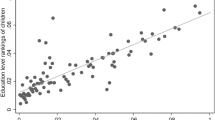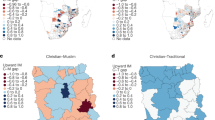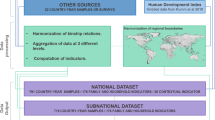Abstract
The extent to which people’s social status is associated with their parents’ status has far-reaching implications for the openness of and stratification in society. Whereas most research focused on the father-child association in advanced economies, less is known about the role mothers play in intergenerational mobility, particularly in a global context. We assembled a dataset of 1.79 million individuals born in 1956–1990 across 106 societies to examine the global patterns of intergenerational educational mobility and how they vary with education expansion and changes in parents’ educational pairing. With education expansion, father-child associations in educational status become weaker and mother-child associations become stronger. With the prevalence of hypogamous parents (mother more educated), mother-child associations are stronger, but father-child associations are weaker. With the prevalence of hypergamous parents (father more educated), mother-daughter associations are weaker. Our global evidence calls for a gender-sensitive understanding of how education expansion matters for intergenerational mobility.
This is a preview of subscription content, access via your institution
Access options
Access Nature and 54 other Nature Portfolio journals
Get Nature+, our best-value online-access subscription
$29.99 / 30 days
cancel any time
Subscribe to this journal
Receive 12 digital issues and online access to articles
$119.00 per year
only $9.92 per issue
Buy this article
- Purchase on Springer Link
- Instant access to full article PDF
Prices may be subject to local taxes which are calculated during checkout






Similar content being viewed by others
Data availability
Secondary data from multinational and national surveys and United Nations archival records were analysed in this study. As the datasets are proprietary and require access permission from the original data collectors/holders, we are unable to make the data publicly available. The datasets and links to apply for and download the data are as follows, with further information provided in Supplementary Information Section 1.1: Encuesta de Caracterización Socioeconómica Nacional (https://www.casen2022.gob.cl/); General Social Survey, Canada (https://www150.statcan.gc.ca/n1/en/catalogue/89F0115X); Chinese General Social Survey (http://cgss.ruc.edu.cn/English/Home.htm); Ecuador Living Conditions Survey (https://www.ecuadorencifras.gob.ec/documentos/web-inec/ECV/ECV_2015/); EDAM – Enquête Djiboutienne auprès des Ménages – Indicateurs Sociaux (https://microdata.worldbank.org/index.php/catalogue/3463); EMOVI – ESRU Social Mobility Survey in Mexico (https://www.icpsr.umich.edu/web/DSDR/studies/35333); Encuesta Nacional de Calidad de Vida (https://www.datos.gov.co/Estad-sticas-Nacionales/Encuesta-Nacional-de-Calidad-de-Vida-ECV-/mz9y-3x9k); European Social Survey (https://www.europeansocialsurvey.org/); European Values Survey (https://europeanvaluesstudy.eu/); Generations and Gender Programme (https://www.ggp-i.org/); General Household Survey, Nigeria (https://microdata.worldbank.org/index.php/catalog/3557); General Social Survey, USA (https://gss.norc.org/); Household Income and Expenditure Survey, Liberia (https://microdata.worldbank.org/index.php/catalog/2986); India Human Development Survey (https://ihds.umd.edu/); The Indonesian Family Life Survey (https://www.rand.org/well-being/social-and-behavioural-policy/data/FLS/IFLS.html); Integrated Household Survey (Gambia: https://microdata.worldbank.org/index.php/catalog/3323/related-materials; Malawi: https://microdata.worldbank.org/index.php/catalog/1003, https://microdata.worldbank.org/index.php/catalog/2936, https://microdata.worldbank.org/index.php/catalog/3818); International Social Survey Programme (https://issp.org/); Japanese General Social Survey (https://csrda.iss.u-tokyo.ac.jp/english/socialresearch/joint/); Korean General Social Survey (https://kossda.snu.ac.kr/handle/20.500.12236/21830); Kagera Health and Development Survey, Tanzania (https://microdata.worldbank.org/index.php/catalog/359, https://microdata.worldbank.org/index.php/catalog/79, https://microdata.worldbank.org/index.php/catalog/2251); Living Conditions Survey (Benin: https://microdata.worldbank.org/index.php/catalog/4291; Burkina Faso: https://microdata.worldbank.org/index.php/catalog/4290; Cote D’Ivoire: https://microdata.worldbank.org/index.php/catalog/2847; Guinea-Bissau: https://microdata.worldbank.org/index.php/catalog/4293; Mali: https://microdata.worldbank.org/index.php/catalog/4295; Niger: https://microdata.worldbank.org/index.php/catalog/4296; Senegal: https://microdata.worldbank.org/index.php/catalog/4297; Togo: https://microdata.worldbank.org/index.php/catalog/4298); Life in Transitions Survey (https://www.ebrd.com/what-we-do/economic-research-and-data/data/lits.html); Labour Market Panel Surveys (Egypt: http://www.erfdataportal.com/index.php/catalog/157; Jordan: http://www.erfdataportal.com/index.php/catalog/139; Tunisia: http://www.erfdataportal.com/index.php/catalog/105); Living Standard Measurement Survey (Albania: https://microdata.worldbank.org/index.php/catalog/64;
Brazil: https://microdata.worldbank.org/index.php/catalog/277;
Ghana: https://microdata.worldbank.org/index.php/catalog?sort_by=rank&sort_order=desc&sk=LSMS+ghana+;
Nigeria: https://microdata.worldbank.org/index.php/catalog/1002); National Income Dynamics Study, South Africa (http://www.nids.uct.ac.za/); National Panel Survey, Uganda (https://microdata.worldbank.org/index.php/catalog/1001/; https://microdata.worldbank.org/index.php/catalog/2663); National Household Sample Survey, Brazil (https://www.ibge.gov.br/en/statistics/social/housing/20620-summary-of-indicators-pnad2.html?=&t=microdados); Socioeconomic Survey (Ethiopia: https://microdata.worldbank.org/index.php/catalog/3823; Ghana: https://microdata.worldbank.org/index.php/catalog/2534; Iraq: https://microdata.worldbank.org/index.php/catalog/2334); STEP Skills Measurement Household Survey (Armenia: https://microdata.worldbank.org/index.php/catalog/2010; Bolivia: https://microdata.worldbank.org/index.php/catalog/2011;
Colombia: https://microdata.worldbank.org/index.php/catalog/2012;
Georgia: https://microdata.worldbank.org/index.php/catalog/2013; Ghana: https://microdata.worldbank.org/index.php/catalog/2015; Kenya: https://microdata.worldbank.org/index.php/catalog/2226; Laos: https://microdata.worldbank.org/index.php/catalog/2016; Macedonia: https://microdata.worldbank.org/index.php/catalog/2568; the Philippines: https://microdata.worldbank.org/index.php/catalog/3182; Sri Lanka: https://microdata.worldbank.org/index.php/catalog/2017; Ukraine: https://microdata.worldbank.org/index.php/catalog/2572; Vietnam: https://microdata.worldbank.org/index.php/catalog/2018); Taiwan Social Change Survey (https://www2.ios.sinica.edu.tw/sc/en/home2.php); World Values Survey (https://www.worldvaluessurvey.org/wvs.jsp) and World Population Prospects (https://population.un.org/wpp/).
Code availability
The codes for data cleaning, harmonization, analysis and production of all graphs and tables reported in the main article and Supplementary Information (Section 1.5) are publicly available through the Open Science Framework at https://osf.io/3q75x/.
References
Torche, F. Analyses of intergenerational mobility: an interdisciplinary review. Ann. Am. Acad. Polit. Soc. Sci. 657, 37–62 (2015).
Morgan, A. C. et al. Socioeconomic roots of academic faculty. Nat. Hum. Behav. https://doi.org/10.1038/s41562-022-01425-4 (2022).
Breen, R. & Jonsson, J. O. Explaining change in social fluidity: educational equalization and educational expansion in twentieth‐century Sweden. Am. J. Sociol. 112, 1775–1810 (2007).
Fischer, C. S. & Hout, M. Century of Difference: How America Changed in the Last One Hundred Years (Russell Sage Foundation, 2006).
Song, X. & Mare, R. D. Short-term and long-term educational mobility of families: a two-sex approach. Demography 54, 145–173 (2017).
Case, A. & Deaton, A. The great divide: education, despair, and death. Annu. Rev. Econ. 14, 1–21 (2022).
Dotti Sani, G. M. & Treas, J. Educational gradients in parents’ child-care time across countries, 1965–2012. J. Marriage Fam. 78, 1083–1096 (2016).
Oreopoulos, P. & Salvanes, K. G. Priceless: the nonpecuniary benefits of schooling. J. Econ. Perspect. 25, 159–184 (2011).
Psacharopoulos, G. & Patrinos, H. A. Returns to investment in education: a decennial review of the global literature. Educ. Econ. 26, 445–458 (2018).
Subramanian, S. V., Huijts, T. & Avendano, M. Self-reported health assessments in the 2002 World Health Survey: how do they correlate with education? Bull. World Health Organ. 88, 131–138 (2010).
Torche, F. in Social Mobility in Developing Countries (eds Iversen, V. et al.) 139–171 (Oxford Univ. Press, 2021).
Barone, C. & Ruggera, L. Educational equalization stalled? Trends in inequality of educational opportunity between 1930 and 1980 across 26 European nations. Eur. Soc. 20, 1–25 (2018).
Shavit, Y. & Blossfeld, H.-P. Persistent Inequality: Changing Educational Attainment in Thirteen Countries (Westview Press, 1993).
Power, C. The Power of Education: Education for All, Development, Globalisation and UNESCO (Springer, 2014).
Narayan, A. et al. Fair Progress? Economic Mobility Across Generations Around the World (World Bank, 2018).
Meyer, J. W., Ramirez, F. O. & Soysal, Y. N. World expansion of mass education, 1870–1980. Sociol. Educ. 65, 128–149 (1992).
Schofer, E. & Meyer, J. W. The worldwide expansion of higher education in the twentieth century. Am. Sociol. Rev. 70, 898–920 (2005).
Thornton, A., Dorius, S. F. & Swindle, J. Developmental idealism: the cultural foundations of world development programs. Sociol. Dev. 1, 277–320 (2015).
Azomahou, T. T. & Yitbarek, E. A. Intergenerational Education Mobility in Africa: Has Progress Been Inclusive? (World Bank, 2016).
Blanden, J. & Macmillan, L. Educational inequality, educational expansion and intergenerational mobility. J. Soc. Policy 45, 615–615 (2016).
Treiman, D. J. Industrialization and social stratification. Sociol. Inq. 40, 207–234 (1970).
Kuznets, S. Economic growth and income inequality. Am. Econ. Rev. 45, 1–28 (1955).
Meschi, E. & Scervini, F. Expansion of schooling and educational inequality in Europe: the educational Kuznets curve revisited. Oxf. Econ. Pap. 66, 660–680 (2014).
Lucas, S. R. Effectively maintained inequality: education transitions, track mobility, and social background effects. Am. J. Sociol. 106, 1642–1690 (2001).
Education at a Glance 2021: OECD Indicators (Organisation for Economic Co-operation and Development, 2021).
Goldscheider, F., Bernhardt, E. & Lappegård, T. The gender revolution: a framework for understanding changing family and demographic behavior. Popul. Dev. Rev. 41, 207–239 (2015).
Van Bavel, J., Schwartz, C. R. & Esteve, A. The reversal of the gender gap in education and its consequences for family life. Annu. Rev. Sociol. 44, 341–360 (2018).
Blanden, J. Cross-country rankings in intergenerational mobility: a comparison of approaches from economics and sociology. J. Econ. Surv. 27, 38–73 (2013).
Breen, R., Luijkx, R., Müller, W. & Pollak, R. Nonpersistent inequality in educational attainment: evidence from eight European countries. Am. J. Sociol. 114, 1475–1521 (2009).
Song, X. et al. Long-term decline in intergenerational mobility in the United States since the 1850s. Proc. Natl Acad. Sci. USA 117, 251–258 (2020).
Breen, R. Education and intergenerational social mobility in the US and four European countries. Oxf. Rev. Econ. Policy 35, 445–466 (2019).
Hertz, T., Tamara, J., Piraino, P., Sibel, S. & Nicole, S. The inheritance of educational inequality: international comparisons and fifty-year trends. B. E. J. Econ. Anal. Policy 7, 1–30 (2007).
van der Weide, R. et al. Intergenerational Mobility Around the World (World Bank, 2021).
Aydemir, A. B. & Yazici, H. Intergenerational education mobility and the level of development. Eur. Econ. Rev. 116, 160–185 (2019).
Chow, A. & Guppy, N. Intergenerational educational mobility over the past century in Canada. Can. Rev. Sociol. 58, 372–398 (2021).
Minello, A. & Blossfeld, H.-P. From mother to daughter: changes in intergenerational educational and occupational mobility in Germany. Int. Stud. Sociol. Educ. 24, 65–84 (2014).
Xie, Y., Dong, H., Zhou, X. & Song, X. Trends in social mobility in postrevolution China. Proc. Natl Acad. Sci. USA 119, e2117471119 (2022).
Beller, E. Bringing intergenerational social mobility research into the twenty-first century: why mothers matter. Am. Sociol. Rev. 74, 507–528 (2009).
Gerber, T. P. & Hout, M. Educational stratification in Russia during the Soviet period. Am. J. Sociol. 101, 611–660 (1995).
Park, H., Buchmann, C., Choi, J. & Merry, J. J. Learning beyond the school walls: trends and implications. Annu. Rev. Socio. 42, 231–252 (2016).
Lareau, A. Unequal Childhoods: Class, Race, and Family Life (Univ. of California Press, 2003).
Craig, L. & Mullan, K. How mothers and fathers share childcare: a cross-national time-use comparison. Am. Sociol. Rev. 76, 834–861 (2011).
Guryan, J., Hurst, E. & Kearney, M. Parental education and parental time with children. J. Econ. Perspect. 22, 23–46 (2008).
Hays, S. The Cultural Contradictions of Motherhood (Yale Univ. Press, 1996).
Jaeger, M. M. Educational mobility across three generations: the changing impact of parental social class, economic, cultural and social capital. Eur. Soc. 9, 527–550 (2007).
Esteve, A. et al. The end of hypergamy: global trends and implications. Popul. Dev. Rev. 42, 615–625 (2016).
Erát, D. Educational assortative mating and the decline of hypergamy in 27 European countries. Demogr. Res. 44, 157–188 (2021).
Eika, L., Mogstad, M. & Zafar, B. Educational assortative mating and household income inequality. J. Polit. Econ. 127, 2795–2835 (2019).
Han, S. W. Is it only a numbers game? A macro-level study of educational hypogamy. Demography 59, 1571–1593 (2022).
Raymo, J. M. & Iwasawa, M. Marriage market mismatches in Japan: an alternative view of the relationship between women’s education and marriage. Am. Sociol. Rev. 70, 801–822 (2005).
World Population Dashboard (United Nations Population Fund, 2022).
Benavot, A. & Riddle, P. The expansion of primary education, 1870–1940: trends and issues. Sociol. Educ. 61, 191–210 (1988).
Williams, R. Using the margins command to estimate and interpret adjusted predictions and marginal effects. Stata J. 12, 308–331 (2012).
Hannum, E. & Buchmann, C. Global educational expansion and socio-economic development: an assessment of findings from the social sciences. World Dev. 33, 333–354 (2005).
Duncan, S. & Edwards, R. Single Mothers in International Context: Mothers or Workers? (Routledge, 2013).
World Population Prospects (UN Population Division, 2019).
Barakat, B. & Shields, R. Just another level? Comparing quantitative patterns of global expansion of school and higher education attainment. Demography 56, 917–934 (2019).
Bhatia, A., Krieger, N. & Subramanian, S. V. Learning from history about reducing infant mortality: contrasting the centrality of structural interventions to early 20th-century successes in the United States to their neglect in current global initiatives. Milbank Q. 97, 285–345 (2019).
Standard Country or Area Code for Statistical Use (UN Statistics Division, 2023); https://unstats.un.org/unsd/methodology/m49/
Snijders, T. A. & Bosker, R. J. Multilevel Analysis: An Introduction to Basic and Advanced Multilevel Modeling (Sage, 2011).
Frees, E. W. Longitudinal and Panel Data: Analysis and Applications in the Social Sciences (Cambridge Univ. Press, 2004).
Mason, C. H. & Perreault, W. D. Collinearity, power, and interpretation of multiple regression analysis. J. Mark. Res. 28, 268–280 (1991).
Wooldridge, J. M. Econometric Analysis of Cross Section and Panel Data (MIT Press, 2010).
Acknowledgements
We thank Y. T. Nip for research assistance with the preliminary screening of Canada’s General Social Survey data, and N. Guppy for helpful comments on the results of our initial analysis. The authors received no specific funding for this work.
Author information
Authors and Affiliations
Contributions
Y.H. and Y.Q. conceptualized and designed the study. Y.H. curated the datasets and conducted the data analysis. Y.Q. conducted analysis replication and validation. Y.H. and Y.Q. wrote, reviewed, revised, edited and finalized the manuscript.
Corresponding authors
Ethics declarations
Competing interests
The authors declare no competing interests.
Peer review
Peer review information
Nature Human Behaviour thanks Sarah Giroux, Jo Blanden and Moris Triventi for their contribution to the peer review of this work. Peer reviewer reports are available.
Additional information
Publisher’s note Springer Nature remains neutral with regard to jurisdictional claims in published maps and institutional affiliations.
Supplementary information
Supplementary Information
Supplementary Methods, Figs. 1–22, Tables 1–10, Results and References.
Rights and permissions
Springer Nature or its licensor (e.g. a society or other partner) holds exclusive rights to this article under a publishing agreement with the author(s) or other rightsholder(s); author self-archiving of the accepted manuscript version of this article is solely governed by the terms of such publishing agreement and applicable law.
About this article
Cite this article
Hu, Y., Qian, Y. Gender, education expansion and intergenerational educational mobility around the world. Nat Hum Behav 7, 583–595 (2023). https://doi.org/10.1038/s41562-023-01545-5
Received:
Accepted:
Published:
Issue Date:
DOI: https://doi.org/10.1038/s41562-023-01545-5



